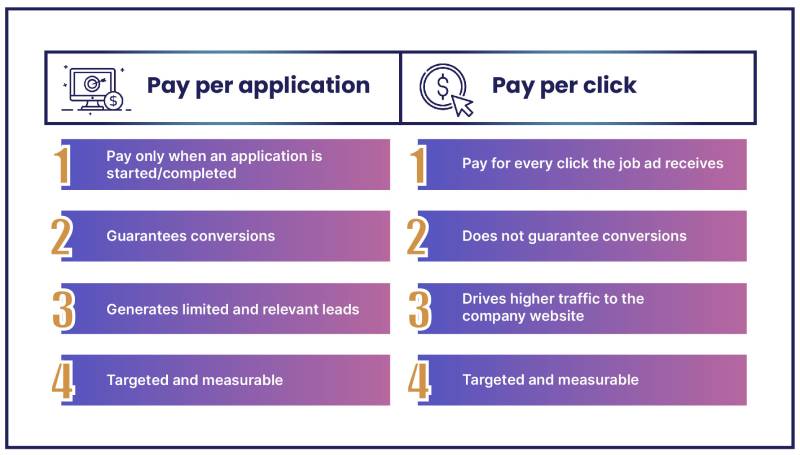While pay per click is one of the most commonly used pricing systems among job boards, pay-per-applicant structures have recently gained momentum.
For example, Indeed recently announced a shift from a pay-per-click to a pay-per-application pricing model. Beginning in 2023, organizations will only pay when candidates start or complete an application.
However, with job boards using a variety of pricing models, choosing the one that works for you can be confusing. This blog will look at the differences between pay-per-application and pay-per-click models, and what to consider when selecting the perfect job board(s) to achieve your recruitment goals.
The Basics of Performance-Based Pricing
Recruitment advertising ensures that your budget is effectively divided among open roles posted across job boards to drive talented candidates to apply. Let’s look at how job boards price their services.
Pay per click (PPC) or cost per click (CPC)
In the PPC or CPC model, websites bill organizations based on the number of times visitors click on an ad.
Job boards display your ad to a large number of job seekers interested in viewing your listing. When candidates click the ad, they are directed to the company site, increasing your official website traffic.
One of the primary reasons for the dwindling popularity of the PPC model is that very few clicks actually translate into applications, which means increased job ad spending.
Pay per application (PPA)
PPA or cost per application (CPA) means organizations only pay for results – when the candidate takes a predetermined action, e.g., conversion. It is a more cost-effective and lower-risk option compared with the PPC model.
It is important to note that organizations interpret “conversion” differently. For some, it is when candidates complete their job applications. For others, a candidate joining their talent network or starting the application counts as a conversion.
The primary advantage of PPA (over PPC) is a reduction in cost, due to irrelevant and unqualified candidates. Organizations often have to pay for fraudulent or unintentional clicks that do not result in candidates. According to Indeed’s new structure, organizations will not have to pay for accidental clicks or individuals who don’t qualify for the role. This will prevent unqualified applicants from entering the pipeline, saving you time and resources.

Pay Per Application vs. Pay Per Click: What’s Our Pick?
Ultimately, while hiring, the goal is to get relevant candidates, right? Does this mean that you should always opt for the PPA model? Is CPC still useful?
The answer to these questions depends on the results you want. Moreover, various job boards have different pricing models, ranging from pay per post and pay per lead, to subscriptions. Niche platforms might cost more than others. Selecting a job site is a holistic decision based on various factors, not just the pricing model. Use the following questions to figure out what works best for you and plan your recruitment advertising strategy accordingly.
What role do you want to hire for?
You will select specialist or generalist job boards, depending on the role you are hiring for. For instance, if you are hiring for tech roles, you might want to target niche job boards like Dice. While expensive, you can develop a talent pool with skilled and relevant candidates without perusing unsuitable profiles.
How much money are you investing in recruitment advertising?
Although pay-per-application models are said to have better results, budgeting for your recruitment efforts is essential. Setting up the recruitment spend depends on the role (easy or hard to fill), target candidates, and hiring time.
Often, entry-level positions receive more responses and applications. Advertising for entry-level positions with pay-per-click models will take up most of your recruitment ad budget due to the sheer number of candidate clicks, leaving little for hard-to-fill roles. While a pay-per-application approach does a better job targeting qualified candidates, breaking into the model might be expensive initially, despite promising long-term results.
Make sure you’re using the right tools and tactics to advertise your jobs in today’s competitive market.
Get Your Hands on the Ultimate Recruitment Advertising Playbook!
How long do you want to run your ad?
hrAnother vital question is the time you run an ad for. With pay-per-click boards, the longer you run the ad, the more cost you incur, depending on the clicks. Application-based pricing only charges you when an application is started.
However, many job boards charge per post, monthly fees, or other payment plan options (subscriptions, flex pricing, etc.). For example, Monster charges USD 279 per job post for 30 days and 50 resume views, while Dribble has various pricing structures ranging from basic to advanced search.
What metrics and analytics does the job board measure?
Most pay-for-performance job boards allow you to track metrics like impressions, clicks, views, traffic sources, user engagement and actions, and trends over time.
Measuring such metrics provides you with valuable insights into your recruitment advertising strategy. For instance, it warrants further investigation if you are not receiving applications from the pay-per-applicant job board. What’s not working? Is it your job ad? Or do you need to change to another site?
Picking a job site that allows you to track metrics important to your goals and objectives.
How can you optimize your ad spend to maximize your results?
Lastly, ask yourself how to optimize your job recruitment advertising spend to achieve desired results. This is where recruitment advertising solutions can help. With automated budget allocation and publishing across job boards, you can enhance your ROI while reducing hiring and application costs.
Ready to Invest in Recruitment Advertising?
As the labor market continues to evolve, investment in recruitment advertising has steadily increased over the years. Recruiters post ads on job boards, social media, and other sourcing channels to attract candidates. Online job boards typically use the pay-per-click model – you pay for every click your ad gets. While it gets you more clicks and web traffic, it does not mean that candidates are interested in (or qualified for) the job.
This year, Indeed announced its updated pay-per-application pricing model – you pay the candidate who applies for the job. It is cost-effective and ensures candidate applications. While both pricing models have pros and cons, selecting one depends on associated factors like hiring goals, job role, duration of ad, budget, and other resources.
Joveo’s award-winning programmatic platform optimizes your ad spend, getting more people in your pipeline at a lower cost. With us, you are only paying for real human job seekers. Book a demo today!














